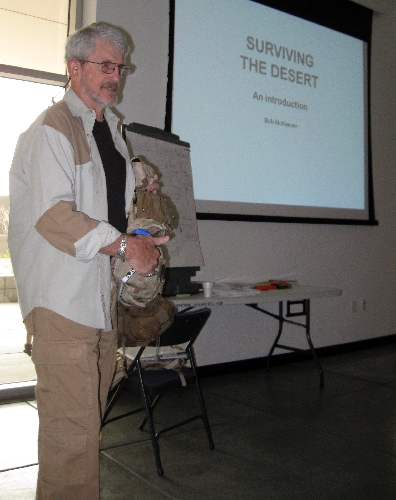Expert educates public about avoiding harm in the Mojave
The desert can be an unforgiving place. The recent deaths of two hikers in separate incidents is evidence of that.
A hike can turn deadly, and there are a number of things that can go wrong. Surviving those challenges takes preparation. That's what Bob McKeever, former park ranger and a Marine, teaches park rangers and other personnel who work in the Mojave Desert.
The animals encountered in the Mojave will not harm you if you leave them alone, he told class attendees March 23. That includes scorpions, rattlesnakes and hela monsters, also known as Gila monsters.
"In order to get a hela monster bite, I'm of the opinion that you need a blood alcohol level of at least 3.0 ," he said.
Rattlesnake bites are not common, but they top the list of animal injuries. If a hiker is bitten by a rattlesnake, the victim should lie down with the bite lower than the heart elevation and keep calm so his heart rate is as slow as possible. His hiking partner can then get help.
"If you run into a rattlesnake, give it 10 feet of space," said Jim Cribbs, park ranger with the Bureau of Land Management and the interagency volunteer coordinator. "That way, it's happy, you're happy. You've had a National Geographic moment. Keep moving."
McKeever shared what he called his Girl Scout 3F rule: Never put your fingers, feet or fanny anywhere you haven't first checked for critters and cactus.
If you are stalked by a mountain lion, back away while keeping eye contact and talking. Fan out your jacket or pull your shirt above your head to appear larger. Never run, as it triggers the animal's innate chase response.
Running is good, however, when it comes to bee attacks. Africanized bees will cut off their pursuit after half a mile.
But the No. 1 hazard in the desert, said McKeever, is not animal attacks but personal injury. Whether from a fall or merely a sprained ankle, the result is the same: Your survival depends on getting help, so the first step occurs before you leave home and involves pen and paper or a phone call ---- let someone know where you're going and when you expect to return. Hiking alone is a personal choice and often not a good one. Take a buddy along.
He cited the rule of threes: Generally, a person can survive three minutes without oxygen, three hours without shelter in extreme weather, three days without water and three weeks without food.
McKeever said high temperatures and an inadequate intake of water can be a hiker's enemies.
"Heat without water and no shade is a killer," he said.
He told of putting his Marine skills to work and trying two purported methods for securing water in the desert. One involved digging a hole, which took more than two hours of hard labor, and lining it with plastic sheeting to collect condensation. In the second, he covered a branch with a plastic bag to pool moisture in the bottom of the bag.
His slideshow included photos of the results. The first technique generated only drops of water and was not worth the effort, and the second, barely enough for a swallow. The lesson: Bring plenty of bottled water.
Craig Topple, a volunteer with the Red Rock Canyon Interpretive Association, learned about finding water in a previous class. He had his own tip.
"There are natural water sources around here," he said. "There are about 50 of them ... if you see a wild burro. A burro in the winter can roam up to 10 miles from a water source. But in the summer, it will only go about two miles. So, if you see a burro in summer, you know you're only a couple miles from water."
McKeever's backpack always includes tubing and a sponge so he can sip water from crevasses or mop it up from tiny pools.
Don't depend on cutting open a cactus for a cool drink of water. You may be poisoning yourself.
"It will dehydrate you and give you the runs, and you'll see weird things, and then you'll die," Cribbs said. "So, not good."
Weather can also be a hiker's nemesis.
Lightning strikes can occur if you're in a flat, open area. It's best to crouch down so you're on the balls of your feet to minimize contact with the ground, his presentation showed, and groups of hikers should spread out so they are 15 to 30 feet apart from one another.
If it's been raining, and you suddenly hear what sounds like a freight train, that means a flash flood is imminent. Get to higher ground as fast as possible.
Personal injury is always a concern for hikers. Even a fall from six feet up has the potential to crush a skull, said McKeever, but more often, the person suffers a broken bone or sprain, yet another reason to always have a hiking buddy who can go for help.
Besides packing water and items that will help you survive an emergency, simple precautions can save unnecessary grief. One of them: Clip your car keys to your belt so you don't lose them on the trail or lock yourself out of your car.
Contact Summerlin/Summerlin South View reporter Jan Hogan at jhogan@viewnews.com or 387-2949.






















